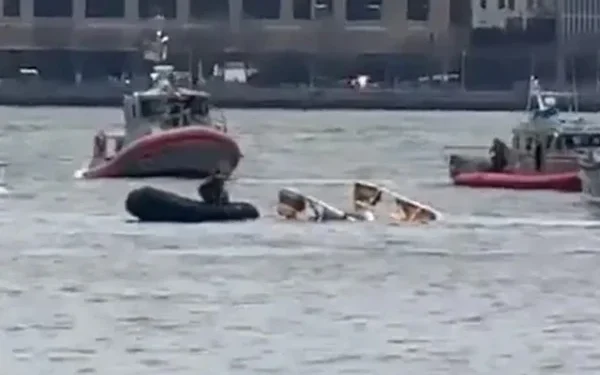Overview of the Incident
A devastating helicopter crash occurred in New York City, resulting in the deaths of six individuals, including three children and three adults. The accident took place over the Hudson River, a prominent waterway that flows between Manhattan and New Jersey, and has raised serious concerns regarding flight safety and tourism aviation protocols in urban centers.
According to local authorities, the helicopter went down near the western shore of Manhattan and quickly capsized in the cold waters of the Hudson River. The passengers on board were Spanish nationals who had traveled to New York for sightseeing purposes.
Details of the Fatal Helicopter Crash
Victims Identified as Tourists from Spain
New York Police Department (NYPD) officials have confirmed that all six victims of the crash were visitors from Spain. The group included three children, two women, and the helicopter’s pilot, who was an experienced American aviator working for a local charter tour company.
The passengers were reportedly on a scenic helicopter ride over Manhattan, a popular activity for international tourists seeking aerial views of landmarks such as the Empire State Building, Central Park, and the Statue of Liberty. Tragically, what was meant to be a joyful memory turned into a heartbreaking incident.
Helicopter Submerged Upside Down
Photos and videos captured by witnesses and released by emergency responders show the helicopter floating upside down in the Hudson River shortly after the crash. The fuselage was partially submerged, and the rotors had detached from the body, indicating a violent impact upon water contact.
Rescue boats, divers, and helicopters were deployed as part of the emergency response. Despite swift action, none of the passengers survived. Some bodies were recovered from the wreckage, while others were located nearby by search divers.
Emergency Response and Rescue Efforts
Coordinated Operation by Land and Naval Units
The New York Fire Department (FDNY) mobilized both land-based teams and marine units to carry out the rescue mission. Firefighters and specialized dive teams responded within minutes of the initial distress call. Coast Guard vessels and NYPD Harbor Patrol units also joined the search and recovery efforts.
FDNY Commissioner Laura Kavanagh stated during a press briefing that rescue teams worked tirelessly, despite difficult conditions in the water, including low visibility and strong currents. “This is one of the most heartbreaking rescue missions we’ve handled in recent memory,” she said.
Rescue Complications Due to Cold Water
Rescuers reported that the cold water temperature in the Hudson River significantly hampered efforts. Hypothermia can occur within minutes, and submerged victims are difficult to locate quickly in such environments. The incident occurred during early spring when river water remains dangerously cold despite rising air temperatures.
Reaction from Officials and Public
Mayor Eric Adams Offers Condolences
New York City Mayor Eric Adams expressed deep sorrow and extended his condolences to the families of the victims. “Our city mourns with the families, especially with our friends from Spain who lost loved ones during their visit,” he stated. The mayor also praised the swift response of emergency teams and promised full transparency in the investigation process.
Spanish Authorities React
The Spanish Consulate in New York confirmed the nationality of the deceased and said it was working closely with U.S. officials to coordinate the repatriation of the victims’ bodies. Spain’s Ministry of Foreign Affairs issued a statement expressing deep regret and offered consular assistance to the grieving families.
Investigation Into the Helicopter Crash
National Transportation Safety Board (NTSB) Launches Investigation
The National Transportation Safety Board (NTSB), which is responsible for investigating civil aviation accidents in the U.S., has taken charge of the probe. A team of aviation experts arrived in New York within hours of the incident and began examining the wreckage and flight data records.
Preliminary reports suggest that mechanical failure or pilot error may have played a role, but investigators are keeping all possibilities open. Witnesses reported hearing a loud “pop” before the helicopter descended rapidly, indicating a potential engine or rotor malfunction.
Federal Aviation Administration (FAA) Involvement
The FAA is working in tandem with the NTSB to determine whether there were any violations of aviation safety regulations. The helicopter’s maintenance records, the pilot’s flight logs, and the company’s operational procedures will all be scrutinized.
Eyewitness Accounts Provide Clues
Several witnesses who were near the riverbank at the time of the crash shared harrowing details. One jogger said he saw the helicopter flying unusually low before it appeared to lose control and plummet into the water. Another eyewitness captured video footage showing the chopper’s rapid descent and the moments after the crash.
Background: Helicopter Tourism in New York
A Popular but Risky Attraction
Helicopter sightseeing tours over New York City are a popular attraction among tourists. Operators offer flights that provide panoramic views of Manhattan’s skyline, Central Park, the Statue of Liberty, and more. However, such tours have faced increasing criticism over the years due to noise pollution and safety concerns.
In 2018, a similar crash involving a sightseeing helicopter led to the deaths of five passengers when the aircraft crashed into the East River. Since then, city and federal authorities have tightened regulations, but critics argue more needs to be done to ensure passenger safety.
Aviation Safety in Urban Areas
Urban aviation remains a complex challenge. Navigating high-density buildings, unpredictable weather, and crowded airspace requires precision and well-maintained equipment. The latest tragedy has reignited calls for stricter oversight and possibly restricting helicopter tours in densely populated cities.
Public Safety and Legal Implications
Potential Lawsuits and Legal Review
Legal experts suggest that the families of the victims may have grounds for wrongful death lawsuits, depending on the findings of the investigation. If negligence, mechanical failure, or regulatory lapses are found, the helicopter tour company could face significant legal and financial consequences.
Policy Reforms Likely
In light of the tragedy, lawmakers and aviation safety advocates are calling for a renewed examination of policies governing non-essential flights over urban centers. City Council members are expected to introduce resolutions to limit or even ban commercial helicopter tours in New York City.
Conclusion: A Tragic Reminder of Aviation Risks
The helicopter crash in New York’s Hudson River is a sobering reminder of the inherent risks associated with air travel, particularly in urban environments. As investigations continue, families are mourning, and officials are working to ensure that similar tragedies do not occur in the future. With rising global tourism and a growing demand for unique experiences like aerial tours, safety must remain a top priority.

























